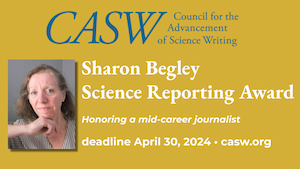If any reporters sitting in the session "Turning the Tables: Meet the Press Critics" have had a piece panned by one of the critics present, they didn't speak up. The three panelists, who participated in ScienceWriters 2008 in October in Palo Alto, instead enjoyed a cordial environment in which they explained how they think science journalists are living up to their responsibilities — and how they're not.
If any reporters sitting in the session "Turning the Tables: Meet the Press Critics" have had a piece panned by one of the critics present, they didn't speak up. The three panelists, who participated in ScienceWriters 2008 in October in Palo Alto, instead enjoyed a cordial environment in which they explained how they think science journalists are living up to their responsibilities — and how they're not.
Charles Petit, who writes a daily blog called the Knight Science Journalism Tracker, insists he is not so much a critic as an observer. Unfortunately, he frequently observes an unsettling homogeneity in daily science journalism, he said. Too often, reporters have clearly taken their story angles — or even direct quotes — straight out of a press release.
For example, in October 2007, the University of Utah issued a release about reproduction methods in primitive plants, entitled "Living fossils have hot sex." Many outlets ran the title nearly verbatim and focused their stories on the "hot sex" aspect, Petit found. The sensationalistic aspect was especially bad in Britain, he said, where headlines for the story added that the fossil sex was also "stinky."
Reporters need to ask themselves, "Do I want my story to look just like the rest of them or not?" Petit said. "It's important to take ownership of a story."
In a different style of critique, Craig Stoltz of Health News Review uses a structured checklist to measure the quality of health reporting. Health News Review's mission is to review health stories with clinical implications that might encourage readers to alter their behavior.
Stoltz and other reviewers evaluate health articles on a set of 10 criteria and then assign between one and five stars to each story. Stories frequently omit discussions of the availability and costs of new treatments as well as evaluations of how new treatments compare with existing alternatives, Stoltz said.
Many reporters also rely too heavily on anecdotes of outliers: people who either suffered an especially severe form of disease or responded especially well to treatment and therefore do not represent typical cases.
Last up was Curtis Brainard, editor of The Observatory, Columbia Journalism Review's online critique of science and environment reporting. Like Petit, Brainard thinks of his job as mainly reading and reacting to science articles, although he also interviews journalists and writes longer features.
Brainard took the audience through a case study of how he evaluated reporting on the potential of genetically modified crops to alleviate food shortages.
In a Q&A session following the presentations, all three panelists emphasized their concern that science reporting is becoming less original and less enterprising. Cross-beat reporting is often among the most original, Brainard said, such as global warming stories that encompass science, politics and business.
According to Petit, though, in the "ecosystem of journalists," there's a place for reporters who do short superficial blurbs as well as for those who do longer, analytical pieces. Summing up what he would like to see in science journalism, "The important thing is to follow your own talents," Petit said, "as long as you're honest and have integrity and all that other crap."
Melissa Lee Phillips is a freelance science writer in Seattle. She has written for The Scientist, New Scientist, Environmental Health Perspectives, and The Lancet Infectious Diseases.
.png)

